Much of what I know is derived from my tests with TTL/BL and the realization that Nikon wireless meters the same as TTL/BL mode . The basic concept I have gathered so far is this : While TTL flash simply fires what it thinks is necessary to light the subject at a given aperture and iso REGARDLESS of the ambient lighting , TTL/BL [ and wireless ] takes the ambient into account and has the ability to add and subtract flash readings taken from individual focus points .
After reading varying opinions on whether using separate channels adds to the exposure or not I decided to do some tests . These are the first three pictures I have taken and they tell me a lot already .
I used a black background so my subject was the lightest object in the frame and exposure would be calculated according to the brightest focus point reading as derived from my previous tests with TTL/BL .
First a picture with one flash at left ....

Then we add another flash on channel 3a as well .....
[EDIT: it may look brighter because more of the face is lit up due to the second flash being closer to the camera]
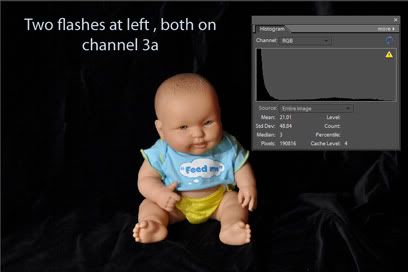
You can see the other flash was closer to the camera as the area above Stinky's left eye is lit up now .... but only half as much as the rest of the face lit by flash - because both flashes fired at half the power of the original exposure .
Then we change one flash to channel 3b - the camera still calculates exposure by adding ambient plus the reading from the other channel[s] and gives similar [ slightly brighter ?] exposure .

I'll do some more tests but I'm already pretty sure that the exposure will stay consistent regardless of what channel the flashes are on .
The only reason I could think of for putting flashes on different channels is that you could then set different exposure compensation for the various channels without walking up to individual flash heads to do this .
Then I made the background white - knowing that Nikon's wireless flash defaults to TTL/BL mode I knew that it would meter for the brightest object under a focus point which would be white and would underexpose . The second shot was at +1.3 compensation to counteract this effect .
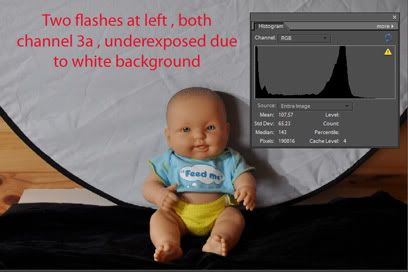
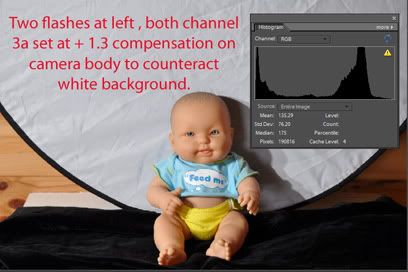
QUOTE from another member :
I've been following some of the posts which basically seem to say, "Group A is set by Nikon to under expose so that if and when you add a flash in group B, the additional light won't be too over exposed since the AWL/CLS system is too stupid to take into account lighting from two (or three) groups."
My reply :
Whoever says that is making a false assumption because they don't understand how TTL/BL meters . As I've shown in my "TTL/BL consistency theory"it meters for the brightest object under a focus point , which is why it underexposes when there is white in the frame . As shown by my recent tests the exposure comes out the same no matter how many channels [ groups ] you have . The fact that TTL/BL has the ability to take ambient into account makes it easy enough to understand that if it can say "x = f-a " [ where "x" = final output , "f " = pre-flash reading and "a" = ambient , in my made up equation ] , it can go a step further and calculate "x = [f1+f2]/2 -a " where "f1" and "f2" are group 3a and 3b pre-flash readings .
It's probably not that simple but basically what I am saying is that if it can take ambient into account , it can take pre-flash readings from different groups into account as well and do the maths .
Tonight I separated the subjects to ensure no interference between pre-flash readings .
First though , I did a few 'normal' shots ..... adding a white object under a focus point causes underexposure again .
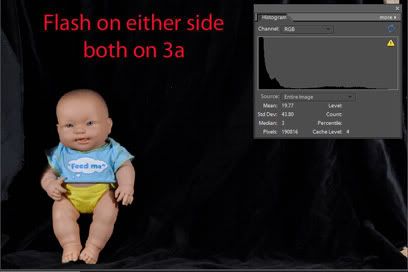
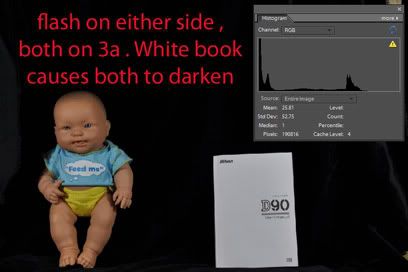
Here we have two flashes on the same channel/group metering off the brightest focus point and adjusting accordingly . The controller doesn't know how many flashes are in each group - it only knows to make sure that the brightest focus point does not overexpose which means underexposure when white is in the frame - as it aims for a neutral gray .
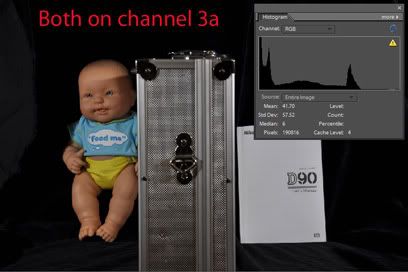
If I move both flashes to the left the exposure is correct for that side - the white paper hasn't interfered with the exposure and the combined output from both flashes is the same as for one flash on that side with no white in the frame .
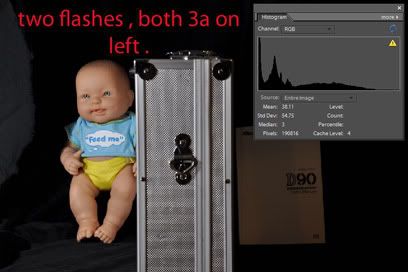
Now if I put the flashes on separate groups and their pre-flash readings can't interfere with each other then the left channel puts out the right amount of flash for Stinky while the right channel underexposes due to the white brochure in the frame . They have each metered for the brightest focus point that they registered on their individual pre-flashes and adjusted accordingly .

I can see a lot of confusion resulting from using different groups without knowing exactly how they will meter . I can also see advantages in using different groups in situations that would call for separate metering in a complicated composition .
For the moment I can see the simplest approach being to use one group no matter how many flashes you are using , and setting compensation on the camera body for the brightest object under a focus point . Any other adjustments for varying degrees of output from different sides could be set on the flash heads themselves .
Also have a look at these interesting tests .



1 comment:
I enjoyed reading thiis
Post a Comment